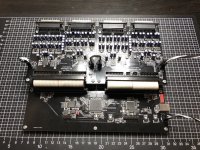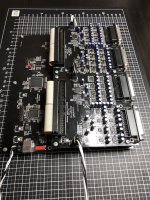Hello diyaudio,
I would like to present you my latest diy project called [Infinitas].
[Infinitas] is a modular USB Audio Class 2 interface.
First there is the interface board itself. The features are:
USB connection for UAC2 operation exposing 32 inputs and 32 outputs to the computer. It uses a XE216 MCU by XMOS. All audio streams are routed to a MachXO2 for signal distributing/routing. The MachXO2 either routes an audio stream to the optional DSP or to the expansion headers.
There is an optional DSP on this board. It is an ADAU1452. This can be easily programmed by SigmaStudio. With this DSP [Infinitas] becomes freeDSP-Infinitas.
As I said the DSP is only an option.
The board has wordclock in and out. It uses a CS2100 for the PLL.
It works at 48kHz, 24bit. Making 96kHz samplerate available will be the next software mod.
To this interface board you can connect up to 32 inputs and 32 outputs.
I have already designed one expansion board with 8 balanced audio inputs and 8 balanced audio outputs utilizing AKM4458 and AKM5558. For my prototype I connected four of these boards to get 32 input and 32 output channels.
Currently, I am busy with designing digital I/O (ADAT, AES3, SPDIF...) expansion boards.
Since this project has a strong connection to the freeDSP project the expansion headers use the freeDSP I2S expansion header pinout.
Because the USB implementation is UAC2 compliant it works driverless for macOS and Linux. It does also work with the usbaudio2 driver of Windows 10 together with asio4all. No additional driver needed. For older Windows versions you have to use one of these open source usbaudio2 drivers from the internet or buy it. Please refer to the XMOS website in order to get some links to driver manufacturers if you are not using Windows 10.
I'ld like it to see other audio enthusiastic makers designing their own expansion boards. Therefore, I made the project open source hardware and published everything on github. Please refer to freeDSP | An Open-Source Low-Budget Audio DSP and watch out for "Infinitas" and "AnalogIO x8". There you will find everything you need.
I hope you enjoy this project as much as I did.
Raphael
I would like to present you my latest diy project called [Infinitas].
[Infinitas] is a modular USB Audio Class 2 interface.
First there is the interface board itself. The features are:
USB connection for UAC2 operation exposing 32 inputs and 32 outputs to the computer. It uses a XE216 MCU by XMOS. All audio streams are routed to a MachXO2 for signal distributing/routing. The MachXO2 either routes an audio stream to the optional DSP or to the expansion headers.
There is an optional DSP on this board. It is an ADAU1452. This can be easily programmed by SigmaStudio. With this DSP [Infinitas] becomes freeDSP-Infinitas.
As I said the DSP is only an option.
The board has wordclock in and out. It uses a CS2100 for the PLL.
It works at 48kHz, 24bit. Making 96kHz samplerate available will be the next software mod.
To this interface board you can connect up to 32 inputs and 32 outputs.
I have already designed one expansion board with 8 balanced audio inputs and 8 balanced audio outputs utilizing AKM4458 and AKM5558. For my prototype I connected four of these boards to get 32 input and 32 output channels.
Currently, I am busy with designing digital I/O (ADAT, AES3, SPDIF...) expansion boards.
Since this project has a strong connection to the freeDSP project the expansion headers use the freeDSP I2S expansion header pinout.
Because the USB implementation is UAC2 compliant it works driverless for macOS and Linux. It does also work with the usbaudio2 driver of Windows 10 together with asio4all. No additional driver needed. For older Windows versions you have to use one of these open source usbaudio2 drivers from the internet or buy it. Please refer to the XMOS website in order to get some links to driver manufacturers if you are not using Windows 10.
I'ld like it to see other audio enthusiastic makers designing their own expansion boards. Therefore, I made the project open source hardware and published everything on github. Please refer to freeDSP | An Open-Source Low-Budget Audio DSP and watch out for "Infinitas" and "AnalogIO x8". There you will find everything you need.
I hope you enjoy this project as much as I did.
Raphael
Attachments
Hi Folks,
i'm currently soldering Infinitas and AnalogIo-x8.
Just wanted to ask if anyone here has already done this, or if anyone is interested to exchange experiences in this regard.
It's pretty demanding to handsolder 0.47pitch and 0402 caps...
No more coffee, sorry
So, should i write a bit, (i think I'm halfway through the parts by now...)?
Best,
Ralf
i'm currently soldering Infinitas and AnalogIo-x8.
Just wanted to ask if anyone here has already done this, or if anyone is interested to exchange experiences in this regard.
It's pretty demanding to handsolder 0.47pitch and 0402 caps...
No more coffee, sorry
So, should i write a bit, (i think I'm halfway through the parts by now...)?
Best,
Ralf
Trouble Flashing the lattice
Rehi,
as noone requested any info on my experience buiding infintas, i left that alone.
Anyway, now I'm running into trouble flashing the lattice:
I built the ftdi-cable, intsalled diamond studio, checked vcc and gnd on the latice-chips pins, seems ok. when i measure voltage over the xtal-pins, i get two different ones... one siginificantly lower than 3.3, one unter 1V.
when i start the programming, i see the TX-led on the ftdi flicker and get some voltage on the pin on the lattice chip, after 2 flicker-sessions, diamod studio tells me there must be st. wrong with the cable.
i assume, i have to power the infinitas, and thus i have no connection in the 3.3V pins on the jtag-pins.
any hints? what can i do to debug some more? i have an ancent osc here, so i could check quite a lot...
thans for any help,
ralf
Rehi,
as noone requested any info on my experience buiding infintas, i left that alone.
Anyway, now I'm running into trouble flashing the lattice:
I built the ftdi-cable, intsalled diamond studio, checked vcc and gnd on the latice-chips pins, seems ok. when i measure voltage over the xtal-pins, i get two different ones... one siginificantly lower than 3.3, one unter 1V.
when i start the programming, i see the TX-led on the ftdi flicker and get some voltage on the pin on the lattice chip, after 2 flicker-sessions, diamod studio tells me there must be st. wrong with the cable.
i assume, i have to power the infinitas, and thus i have no connection in the 3.3V pins on the jtag-pins.
any hints? what can i do to debug some more? i have an ancent osc here, so i could check quite a lot...
thans for any help,
ralf
rehi,
in the meantime i could figure out that there is signal at the OSC-pin of the lattice-fpga, which disappears when i shot the ENA pin of the oscillator to GND, so that should work. (would expact a square, but get a pretty sine, but that migt stem from the 20MHz Bandwith of my old HAMEG...).
I checked continuity from the FTDI to the pins on the FPGA, no shorts either...
Still: Diamond studio does not connect to the FPGA.
Any Hints?
@raphael: in another thread you mentiioned a german forum. Do you have a pointer?
best,
Ralf
in the meantime i could figure out that there is signal at the OSC-pin of the lattice-fpga, which disappears when i shot the ENA pin of the oscillator to GND, so that should work. (would expact a square, but get a pretty sine, but that migt stem from the 20MHz Bandwith of my old HAMEG...).
I checked continuity from the FTDI to the pins on the FPGA, no shorts either...
Still: Diamond studio does not connect to the FPGA.
Any Hints?
@raphael: in another thread you mentiioned a german forum. Do you have a pointer?
best,
Ralf
Sorry for the delay. Somehow I did not recognize you. Sorry.
Anway, can you post a screenshot of the configuration page for the programming cable in Lattice Diamond?
The oscillator has nothing to do with the JTAG configuration. Even without it you should be able to talk to the MachXO. The makes me thinking that there might be a wrong configuration or a driver issue.
Raphael
P.S. Greetings to my old home town!
Anway, can you post a screenshot of the configuration page for the programming cable in Lattice Diamond?
The oscillator has nothing to do with the JTAG configuration. Even without it you should be able to talk to the MachXO. The makes me thinking that there might be a wrong configuration or a driver issue.
Raphael
P.S. Greetings to my old home town!
Hi Raphael
I am currently building the infinitas board, and one of the last components missing is IC202 (NCP4681DSQ25T1G). I can't find this part (farnell, mouser, digikey) or any compatible one (the NCP seems to use an exotic pinout configuration)
Because I already have soldered most of the parts, it is not feasible to change the board layout for me.
Any suggestions (where I can find the part, or do you know of any compatible ones)?
Regards
Godfried
I am currently building the infinitas board, and one of the last components missing is IC202 (NCP4681DSQ25T1G). I can't find this part (farnell, mouser, digikey) or any compatible one (the NCP seems to use an exotic pinout configuration)
Because I already have soldered most of the parts, it is not feasible to change the board layout for me.
Any suggestions (where I can find the part, or do you know of any compatible ones)?
Regards
Godfried
How about this one:
https://fi.farnell.com/on-semiconductor/ncp4620hsq25t1g/ldo-volt-reg-0-15a-2-5v-sc70-5/dp/2464263
NCP502 and NCP 512 and many other seem to use the most common pinout (1=input, 2=GND, 3=EN, 4=PB/N.C, 5=output). Maybe next rev. boards should be changed to use that one, too?
https://fi.farnell.com/on-semiconductor/ncp4620hsq25t1g/ldo-volt-reg-0-15a-2-5v-sc70-5/dp/2464263
NCP502 and NCP 512 and many other seem to use the most common pinout (1=input, 2=GND, 3=EN, 4=PB/N.C, 5=output). Maybe next rev. boards should be changed to use that one, too?
Thanks. This one is not available at farnell Belgium (doesn't even find the order code). Apparently, it is available in the UK. I'll see if I can order there.
HI! the project is beautiful, but I notice that it seems to have stalled a bit after its debut, or am I wrong? The idea that came to me was to create an opensource hardware digital mixer (I don't think there are any) with typical functions (eqs compression bus etc). I have some ideas in my head. Do you think ADAU1452 could support the workload of processing 64 channels at low latency or would they need more powerful processors ( like ADAU1467 ) or dedicated ad hoc processor and software (not sigma studio)? Could someone be interested in developing the idea?
Last edited:
Did anybody manage to make this thing work? I built an Infinitas board and 1X ADC/DAC board, but on my computer (I tried with Win and MacOS) doesn’t show up any new device. Voltages on the board are fine, solder joints are fine (checked witha microscope) and I successfully flashed both the XMOS chip and the FPGA (I’m not using the DSP chip).
- Home
- Source & Line
- Digital Line Level
- [Infinitas] USB Audio Class 2, freeDSP, 32 in, 32 out

